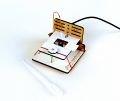No edit summary |
|||
| Line 82: | Line 82: | ||
====Medium==== | ====Medium==== | ||
*[http://file.southernbiological.com/Assets/Products/Specimens/Living_Specimens_and_Supplies/Culture_Media/CM1-Amoeba_culture_medium/CM1_Amoeba_CultureMedium.pdf Amoeba Culture Medium] | *[http://file.southernbiological.com/Assets/Products/Specimens/Living_Specimens_and_Supplies/Culture_Media/CM1-Amoeba_culture_medium/CM1_Amoeba_CultureMedium.pdf Amoeba Culture Medium] | ||
Revision as of 15:53, 18 October 2017
DIY Microscopy
Gallery
Related projects
Ingmar Riedel-Kruse lab at stanford university
Trap it!, http://web.stanford.edu/group/riedel-kruse/publications/CHI517-lee.pdf
Museum visitors could use blue, green or red light to draw patterns on the screen and observe how the Euglena reacted. The microorganisms avoided blue light, so drawing a circle around one of the microbes would trap it, which became the name for one of the scientific mini-games
Euglena soccer, https://www.youtube.com/watch?v=3lwU9deF8rw start at 27:05, https://www.youtube.com/watch?v=Pdx7BkYSCq4
Players earn points by guiding the Euglena through the goal posts.
GMU
Blocksworld repopulated! (2016), http://biogames.eu/
“The BioGame ‘Blocksworld repopulated!’ gives you the opportunity to plunge into a labyrinth populated by microorganisms that you can interact with. Instead of encountering programmed entities in ‘Blocksworld repopulated!’ you are playing with living Euglenas, uni-cellular organisms that are part plants and part animals.”
Protists
A protist is any eukaryotic organism that is not an animal, plant or fungus. The protists are unicellular or unicellular-colonial and form no tissues.
Euglena
Classification
- Domain: Eukaryota
- Class: Euglenoidea
- Genus: Euglena
Description
Euglena is a (endo)symbiotic creature. It is considered belonging to protista kingdom, having features of animal, plant or fungus.
“Euglena are found in fresh and salt waters. They are often abundant in quiet inland waters where they may bloom in numbers sufficient to color the surface of ponds and ditches green (E. viridis) or red (E. sanguinea).” (wikipedia)
"Euglena is a mixotroph (or facultative photoautotroph): it is a photoautotrophic organism because it can utilize carbon dioxide as a carbon source in the presence of light through photosynthesis in chloroplasts and ammonium and nitrate as nitrogen sources; and it is also a heterotrophic organism because it can utilize dissolved organic compounds as carbon source. " (http://www.metamicrobe.com/euglena/)
“Most species of Euglena have photosynthesizing chloroplasts within the body of the cell, which enable them to feed by autotrophy, like plants. However, they can also take nourishment heterotrophically, like animals.” (wikipedia)
Life cycles
- Free-swimming flagellated form
- Palmella
- Cyst
Medium #1
"Combine 1 L of spring water or Chalkley’s 1x solution or Pringsheim’s, 20 wheat or rice grains, and 5 mL (1 tsp) of dry powdered milk in a beaker. Boil the mixture for 5–10 minutes, and then dilute this mixture with 3 L of spring water. Let this solution cool and stand uncovered for 24 hours. Shake or stir the media solution and fill shallow containers with wide bottoms approximately half full. (Stacking culture bowls work best.) Add 50–100 mL of Euglena stock culture to each bowl. The Euglena culture medium contains a great deal of organic matter. Bacteria will grow rapidly and the cultures are likely to have a pungent odor for several days. (Take this into consideration when selecting a culture storage location.)
Chalkley’s Stock Solution 10x (Dilute by a factor of 10 for 1x (e.g., dilute 100 mL to 1 L with distilled water))
0.06 g CaCl2 1.00 g NaCl 0.04 g KCl 1 L Distilled water
Medium #2
More info
Amoeba
"Amoebe is an organism which has the ability to alter its shape, primarily by extending and retracting pseudopods."(wikipedia).
"An Amoeba is unable to form its food from simple substances, but it requires ready-made organic substances for food; such a mode of nutrition in which solid organic particles are ingested is called zoo trophic or holozoic."(http://www.biologydiscussion.com/invertebrate-zoology/protozoa/amoeba-proteus-habitat-structure-and-metabolism/28183)
"A. proteus can be called 'immortal', as it does not die due to natural death on its own, due to binary fission. .. A. proteus reproduces asexually and so it simply copies its genetic information into the second cell." (https://davidwangblog.wordpress.com/life-cycle-and-reproduction/)
"Amoebae move and feed by using pseudopods, which are bulges of cytoplasm formed by the coordinated action of actin microfilaments pushing out the plasma membrane that surrounds the cell. Typically, an amoeba moves by extending a pseudopod, attaching it to the substrate and filling it with cytosol, then releasing its rear portion from attachment to the substrate, which results in the organism being propelled forward."(wikipedia)
"A pseudopod or pseudopodium (plural: pseudopods or pseudopodia) (from the Greek word ψευδοποδός, ψευδός "false" + ποδός "foot") is a temporary cytoplasm-filled projection of a eukaryotic cell membrane or a unicellular protist. Pseudopods may be used for motility, or for ingesting nutrients or other particulate matter."(wikipedia)






